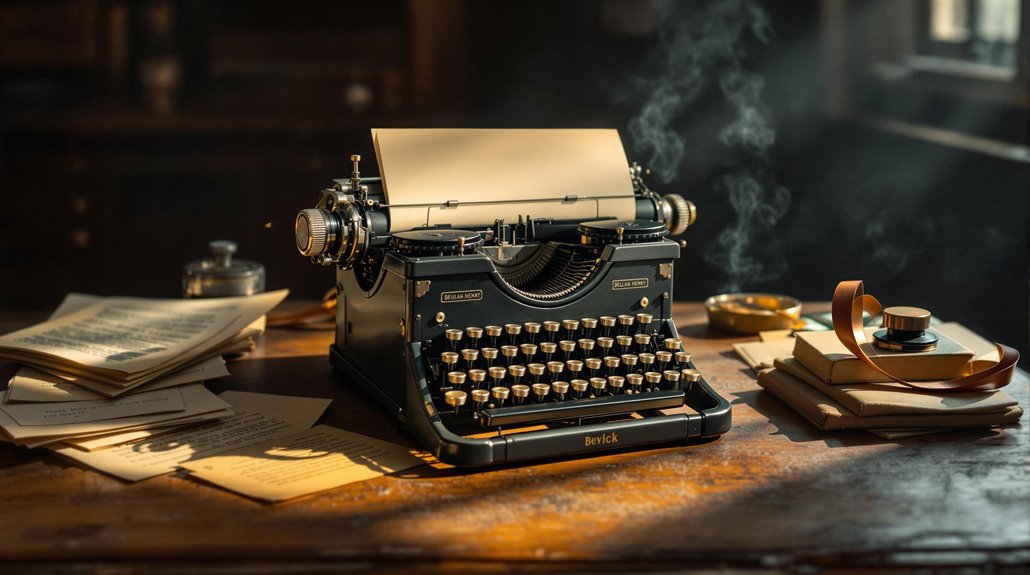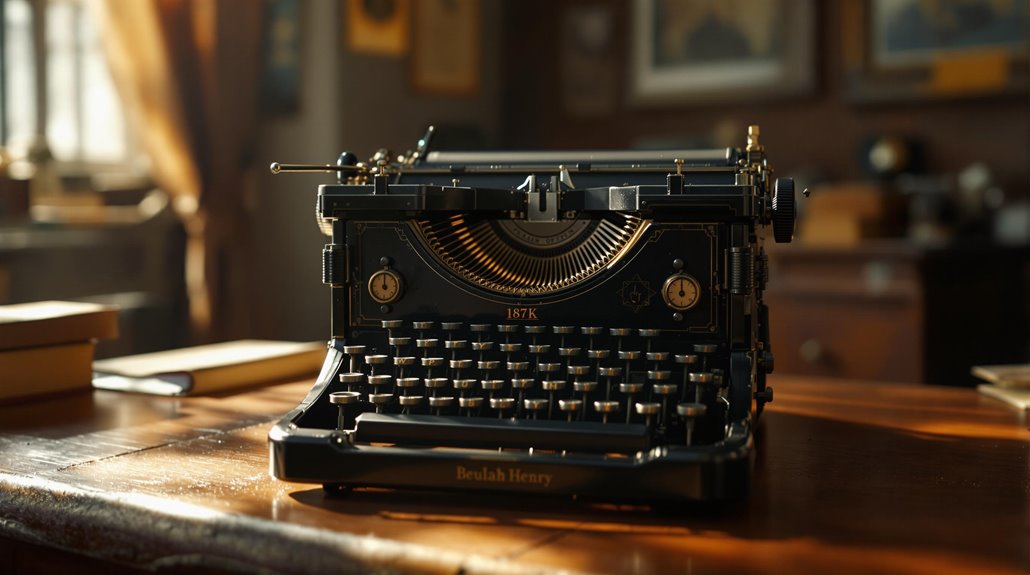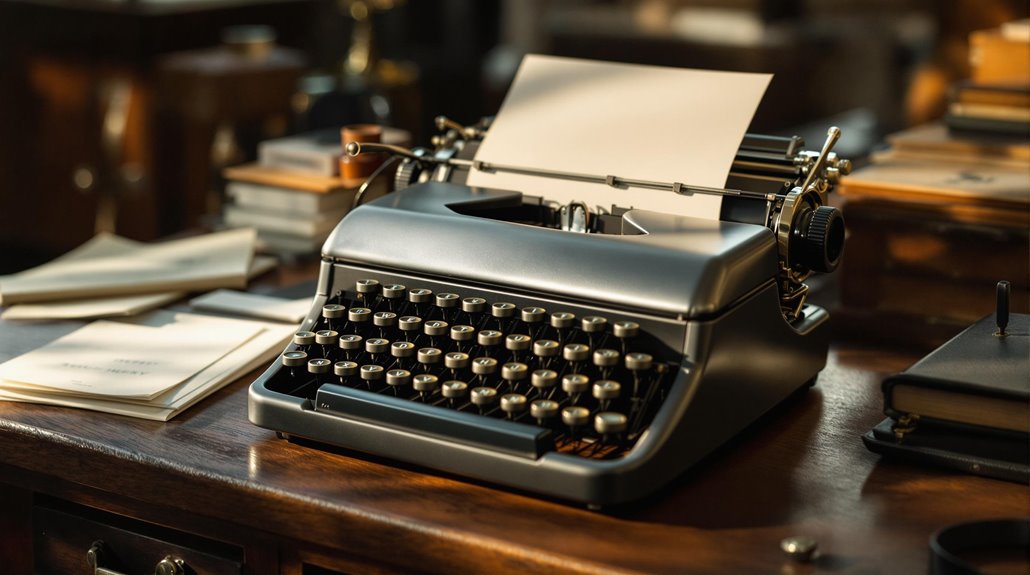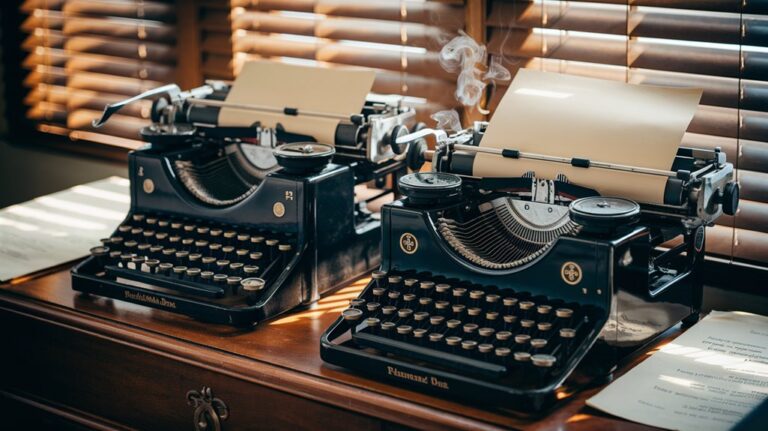Beulah Henry’s Never-Ending Notebook: Her Carbon-Copy Typewriter That Killed Typing Errors
Like a symphony conductor orchestrating multiple instruments at once, Beulah Louise Henry transformed the chaotic world of document creation into a harmonious process. You've probably wrestled with making copies of important papers, but in the 1930s, this task was a nightmare of smudged carbon paper and countless do-overs. That's until "Lady Edison" stepped in with her Never-Ending Notebook, a device that didn't just solve the multiple-copy problem—it revolutionized how we'd handle documents for decades to come.
The Typewriter Revolution Before Carbon Copies

While today's digital age makes copying documents effortless, the typewriter's evolution marked humanity's first major leap toward efficient written communication. You can trace this typewriter evolution back to 1575 when Francesco Rampazetto created the scrittura tattile, followed by Pellegrino Turri's groundbreaking design for his blind friend in 1808.
The real breakthrough came with Sholes and Glidden's 1868 model, manufactured by Remington. Their early innovations, including the QWERTY keyboard layout, set the foundation for modern typing. The machine's inked ribbon system allowed for clear, consistent printing.
You'll find that subsequent developments like the Remington Model 2's shift-key mechanism and Underwood 1's visible typing area transformed these machines from luxury items into essential business tools. The introduction of power-operated typewriters in 1914 by James Fields Smathers further revolutionized typing efficiency.
These advancements revolutionized office work and opened new professional doors for women, particularly in business ownership and the suffrage movement.
Meet Lady Edison: The Mind Behind Multiple Copies
As typewriters transformed offices across America, one brilliant inventor was about to revolutionize document reproduction. Beulah Louise Henry, known as "Lady Edison," tackled inventive challenges with remarkable intuition and self-taught expertise.
By 1924, she'd moved to New York City, where her creative spirit flourished. Her entrepreneurial drive led her to establish the B. L. Henry Company to commercialize her innovations. Her groundbreaking protograph typewriter attachment eliminated the need for messy carbon paper when making multiple copies.
Henry's inspirations came from everyday problems she observed, leading to an astounding career:
- Secured 49 U.S. patents, starting with a vacuum-sealed ice cream freezer
- Created over 110 inventions spanning multiple industries
- Supported herself independently through inventing – rare for women of her era
- Earned recognition from the National Inventors Hall of Fame in 2006
As the granddaughter of North Carolina's governor and a self-educated innovator, Henry proved that genius knows no bounds.
How Henry's Carbon-Copy Innovation Changed Office Life
When Beulah Henry introduced her carbon-copy typewriter in the 1920s, she transformed office workflows forever.
You'd no longer need to worry about messy carbon paper staining your hands or clothes, and office productivity soared as you could create up to four pristine copies simultaneously.
The typing efficiency gains were remarkable.
You'd save countless hours by eliminating the need to retype documents for additional copies, and your document management became greatly easier.
With cleaner originals and improved legibility across all copies, you could distribute memos and reports more effectively than ever before.
As a consultant for Nicholas Machine Works, she continued refining her typewriter innovations from 1939 to 1955.
Henry's innovation didn't just clean up the workplace; it revolutionized how you'd handle paperwork.
The ability to use different paper types for copies and track revisions made document archiving a breeze, setting new standards for modern office equipment.
Beyond Typing: The Economic Impact of Simultaneous Copies
The economic ripples of Henry's carbon-copy typewriter extended far beyond the simple act of typing. Through enhanced document efficiency, businesses experienced dramatic cost reductions and productivity gains that transformed office automation forever.
You'll appreciate how this innovation revolutionized workplace economics through:
- Instant creation of multiple copies, saving countless hours previously spent retyping
- Elimination of expensive correction materials and associated labor costs
- Streamlined document distribution that accelerated business communication
- Reduced need for manual transcription staff while creating new specialized roles
The impact reshaped entire industries, from paper manufacturing to information management. The innovations created indirect employment through expanded supplier networks and support services. Modern businesses continue to benefit from the same principles through document management systems that simplify file organization and retrieval.
While secretaries needed to adapt their skills, the increased productivity expectations ultimately led to higher-value work and the evolution of modern office practices.
This shift in document management efficiency continues to influence today's digital workplace solutions.
From Patent to Progress: Henry's Legacy in Modern Document Management

Following her groundbreaking 1932 Protograph patent, Beulah Henry's innovations in document management spawned decades of technological evolution that shaped modern office equipment.
Her patent evolution continued through 1970, with 12 specific improvements to typewriter technology focusing on paper feeding, alignment, and enhanced efficiency.
You'll find Henry's influence in today's multifunction printers and photocopying systems, which build upon her fundamental concept of producing simultaneous copies without carbon paper.
Her emphasis on user-centered design and document efficiency transformed office workflows, eliminating the mess of carbon paper while increasing typing speed and reducing material costs.
The principles behind her continuously-attached envelopes and multiple-copy systems remain relevant in modern mass mailing and digital document management, proving that her vision extended far beyond her time.










